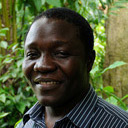
The recent US-Africa Leaders Summit brought attention to several initiatives that seek to improve resilience and biodiversity in Central Africa—and illuminated opportunities and challenges for future development in this region.
The theme of the summit in Washington was “Investing in the Next Generation”—and two summit sessions were of particular relevance to the next generation of communities and forests of the Congo Basin.
One session sought to address the problems of wildlife trafficking in Africa, a rampant problem that threatens the biodiversity of continent—and especially the Congo Basin, an area of critical biodiversity.
This session was an occasion for the US to underscore its efforts in trying to combat illegal trafficking, including its Wildlife Enforcement Network (WEN) in the Horn of Africa. The US is seeking to eventually extend the WEN to Central Africa. An important aspect of this initiative—and a fitting approach to the “next generation” theme of the summit—is the recruitment of youths as park rangers and in natural resources management.
Challenges remain to biodiversity conservation in this region, however. In Central Africa, the wildlife sector has not yet generated enough funding to ensure its effective management, security and sustainability. Moreover, criminalizing smallholders who are hunting for wildlife for sustenance—as is currently the case throughout much of Central Africa—will not help to solve the crisis of unsustainable hunting of bushmeat. Without a permanent source of income to sustain biodiversity conservation in and around protected areas, it remains difficult to effectively combat wildlife trafficking in Central Africa and to halt declining wildlife populations.
The second session of note dealt with resilience and food security in a changing climate. US efforts in this realm are rooted in the “New Alliance for Food Security and Nutrition,” which aims to lift 50 million people out of poverty in sub-Saharan Africa by 2022—similar to efforts by the African Union, with its own milestone of 2025.
Climate-smart agriculture was pitched as a way forward for the continent. The challenge for the Congo Basin and Central Africa in general is to find a way to mainstream agriculture in natural resource management at the national and regional scales. In the landscape planning process, agriculture needs to be seen as a business that can be sustainable. Instead of vilifying agriculture (particularly smallholder agriculture) as a driver of deforestation, stakeholders in this sector need to be involved in the planning and execution of biodiversity conservation and management initiatives.
The agricultural sector in the Congo Basin can also help to achieve both mitigation and adaptation to climate change—but efforts to do this in other parts of the continent often miss the region. On climate change resilience, the US-backed Global Resilience Partnership focuses primarily on the Sahel and the Horn of Africa, for example. Despite the recent reaffirmation of African Union that “adaptation is a priority in all actions on climate change in Africa,” climate-change responses are different in the heart of the continent. In Central Africa, besides Lake Chad (where droughts illustrate how climate change is silently impacting ecosystems), the Congo Basin is not yet a subject of high interest for continental resilience initiatives.
This is partly due to lack of information on the vulnerability of communities and forests in this region: Meteorological and hydrological stations inherited from the colonial period are now obsolete, for example, and less research is taking place in Central Africa than in other parts of Africa. Gradual information/outputs from the Cofcca and Cobam projects are helping to correct this, though, filling information gaps and revealing that this part of the continent also deserves attention for adaptation to climate change.
The summit, true to its name, put the future generation at the center of the discussion. Institutions such as the University of California-Berkeley received youths participating in the Young African Leaders Initiative (YALI) in the lead-up to the summit. But as CIFOR researchers and colleagues of the University of Prince Edward Island (Canada) found recently, at the local level, youths are not included in the decision-making process in rural areas. Actions to rectify this are under way, though: Recognizing that youths are the next frontier of forest management, an entire session at the Global Landscapes Forum, a side event to the UNFCCC COP in Warsaw last year, was dedicated to youths. On achieving food security and climate change resilience in Central Africa, the potential of youths must not be left untapped.
At its heart, though, the summit was an occasion to reflect on US-Africa relations and how they relate to environmental issues in the Congo Basin. The CARPE initiative as well as US facilitation of the CBFP constituted milestones in the cooperation between the US and Central African states in the environmental sector.
Alongside interest in wildlife trafficking, adaptation to climate change and food security (particularly climate-smart agriculture) constitutes untapped opportunities to alleviate the vulnerabilities of forests and communities in the heart of Africa.
We want you to share Forests News content, which is licensed under Creative Commons Attribution-NonCommercial-ShareAlike 4.0 International (CC BY-NC-SA 4.0). This means you are free to redistribute our material for non-commercial purposes. All we ask is that you give Forests News appropriate credit and link to the original Forests News content, indicate if changes were made, and distribute your contributions under the same Creative Commons license. You must notify Forests News if you repost, reprint or reuse our materials by contacting forestsnews@cifor-icraf.org.














